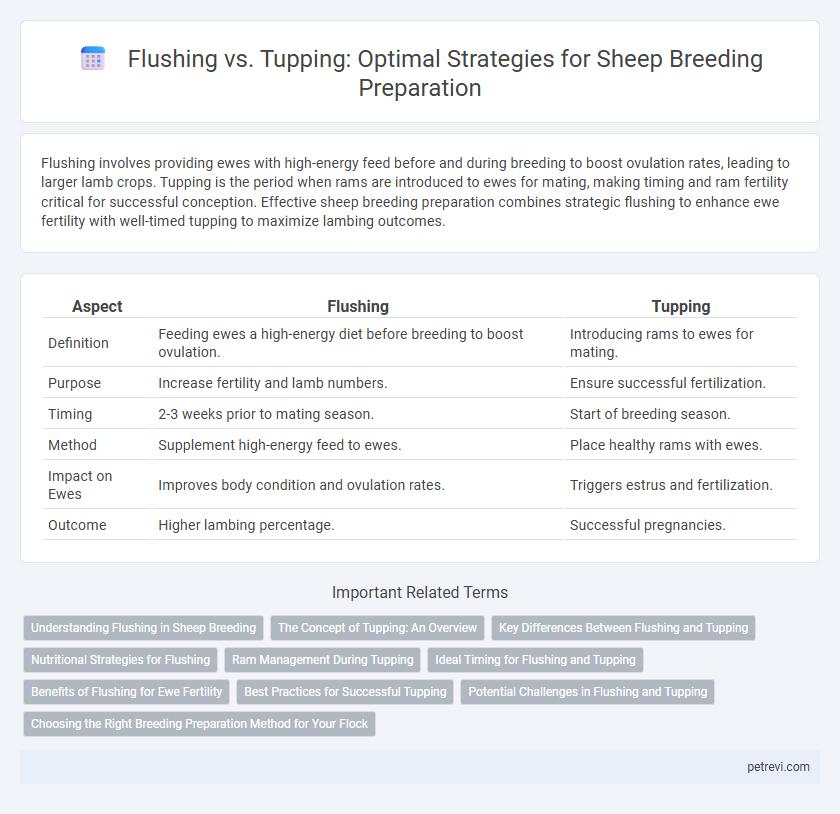Flushing involves providing ewes with high-energy feed before and during breeding to boost ovulation rates, leading to larger lamb crops. Tupping is the period when rams are introduced to ewes for mating, making timing and ram fertility critical for successful conception. Effective sheep breeding preparation combines strategic flushing to enhance ewe fertility with well-timed tupping to maximize lambing outcomes.
Table of Comparison
| Aspect | Flushing | Tupping |
|---|---|---|
| Definition | Feeding ewes a high-energy diet before breeding to boost ovulation. | Introducing rams to ewes for mating. |
| Purpose | Increase fertility and lamb numbers. | Ensure successful fertilization. |
| Timing | 2-3 weeks prior to mating season. | Start of breeding season. |
| Method | Supplement high-energy feed to ewes. | Place healthy rams with ewes. |
| Impact on Ewes | Improves body condition and ovulation rates. | Triggers estrus and fertilization. |
| Outcome | Higher lambing percentage. | Successful pregnancies. |
Understanding Flushing in Sheep Breeding
Flushing in sheep breeding involves increasing the nutritional intake of ewes before and during the tupping period to improve ovulation rates and overall fertility. This practice typically includes feeding high-energy diets rich in concentrates to boost body condition scores and promote the development of multiple follicles. Effective flushing can lead to higher lambing percentages by enhancing ewe reproductive performance compared to sheep that do not undergo this nutritional strategy.
The Concept of Tupping: An Overview
Tupping is the process of mating rams with ewes during the breeding season to achieve successful conception and lambing. It involves carefully selecting rams based on genetics, health, and fertility to enhance flock performance and genetic improvement. Proper management during tupping, including timing and ram-to-ewe ratios, is critical to optimize pregnancy rates and overall reproductive success.
Key Differences Between Flushing and Tupping
Flushing involves increasing the nutritional intake of ewes prior to breeding to enhance ovulation rates and improve conception chances, while tupping refers to the actual mating process where rams are introduced to ewes. Flushing primarily impacts fertility by stimulating multiple ovulations, whereas tupping focuses on successful fertilization and timing. Proper execution of flushing ensures ewes enter the tupping phase with optimal reproductive condition, increasing lambing success.
Nutritional Strategies for Flushing
Flushing in sheep breeding involves increasing the ewe's plane of nutrition two to three weeks before tupping to enhance ovulation rates and embryo survival. Nutritional strategies for flushing emphasize high-energy diets rich in carbohydrates and protein, incorporating concentrates and high-quality forage to boost body condition scores from 2.5 to 3.5. Effective flushing improves reproductive performance by stimulating follicular development and increasing conception rates, making diet optimization crucial in pre-breeding management.
Ram Management During Tupping
Effective ram management during tupping involves maintaining optimal nutrition, health, and body condition to ensure high fertility rates. Rams should be gradually introduced to ewes to prevent injury and stress, with careful monitoring for signs of overheating or fatigue to maximize breeding performance. Strategic rest periods and controlled exposure to ewes improve ram libido and sperm quality, enhancing overall flock reproductive success.
Ideal Timing for Flushing and Tupping
Flushing in sheep breeding is ideally initiated 2 to 3 weeks before tupping to enhance ewe fertility and ovulation rates through improved nutrition. Tupping should be timed during the ewe's natural estrous cycle peak, typically in autumn or early spring, depending on breed and environmental conditions. Proper synchronization of flushing and tupping optimizes conception rates and overall flock reproductive performance.
Benefits of Flushing for Ewe Fertility
Flushing enhances ewe fertility by increasing nutrient intake before breeding, which boosts ovulation rates and improves embryo survival. This technique promotes better body condition, resulting in higher lambing percentages and healthier offspring. Optimal flushing protocols can lead to more efficient reproductive performance and increased flock productivity.
Best Practices for Successful Tupping
Flushing boosts ewe fertility by increasing energy intake 2-3 weeks before tupping, enhancing ovulation rates and conception success. Tupping preparation requires selecting healthy, well-conditioned rams and monitoring ewe nutrition closely to ensure optimal mating conditions. Maintaining a stress-free environment and proper timing of tupping optimizes lambing percentages and overall flock productivity.
Potential Challenges in Flushing and Tupping
Flushing in sheep breeding can lead to challenges such as over-conditioning, which may cause scouring and reduce fertility rates. Tupping risks include stress from ram introduction and aggressive behavior that can impact ewe health and mating success. Proper management of nutrition and monitoring during both flushing and tupping are crucial to mitigate these potential reproductive setbacks.
Choosing the Right Breeding Preparation Method for Your Flock
Flushing increases ewe fertility by boosting nutrition and energy intake before breeding, optimizing ovulation rates and lambing outcomes. Tupping involves controlled exposure of rams to ewes during the breeding season to synchronize and maximize conception rates. Selecting between flushing and tupping depends on flock nutritional status, ram activity, and specific breeding goals to enhance reproductive efficiency.
Flushing vs Tupping for Sheep Breeding Preparation Infographic

 petrevi.com
petrevi.com